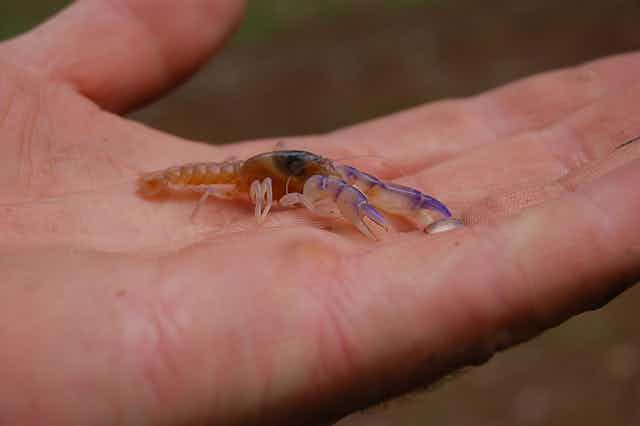Australia boasts the largest freshwater crayfish in the world. But less well known are the much smaller crayfish that live, not in rivers, lakes or dams, but in burrows. Australia has several types of burrowing crayfish, all of which have small tails and large claws.
The south west of Western Australia is a biodiversity hotspot with a significant number of endemic freshwater crayfish, including the genus Engaewa, to which the Margaret River burrowing crayfish belongs. This beautiful name has a rather prosaic origin: it is made up of the name for a group of burrowing crayfish in eastern Australia, Engaeus, and the abbreviation of the state of Western Australia.

Engaewa were first described in the 1950s with three species. The Margaret River burrowing species (Engaewa pseudoreducta) and a fifth species were more recently described.
The biogeography of Engaewa is the subject of study for PhD candidate Quinton Burnham: using morphological and DNA evidence two additional species were discovered, taking the total to seven.
Notwithstanding their small size (less than 5cm in length), burrowing crayfish can be viewed as “ecosystem engineers”. Their burrows aerate and turn over the soil, providing air and nutrients to plant roots. A number of other animals make the burrows their exclusive home.
Burrowing crayfish are not so easy to study, because, in WA at least, they rarely spend time on the surface. Engaewa burrows are complex, branching structures 4m deep or more and are often hidden in dense vegetation. Burrows usually go down to the water table, with a chamber that is partially filled with water.
The most productive method of collecting these crayfish is to dig out their burrows: an exhausting and often unrewarded pursuit. On rare occasions, such as an incredibly stormy night, you might get lucky and be able to find them on the surface in puddles by spotlight.
Status
Of the five species of Engaewa currently recognised, three are listed. The Margaret River burrowing crayfish, E. pseudoreducta, is listed as critically endangered under state and federal legislation and with the IUCN red list. Two other species are vulnerable.

Quinton’s morphological and DNA evidence confirms that the Margaret River burrowing crayfish is a valid species, and allows definitive identification if new populations are located.
The original locality from which the Margaret River burrowing crayfish was first described is now a tree plantation and the animals are no longer found there. Despite extensive searching throughout the area, there are now only two locations, about 2 km apart, from which the Margaret River burrowing crayfish are known. No specimens have been collected for several years from one of those.
Threats
There are several characteristics that make the Margaret River burrowing crayfish and other members of the genus particularly vulnerable to extinction. Most notably Engaewa have very limited ability to disperse: most species spend very little time above ground and have small, disconnected populations.
Burrowing crayfish also need to reach the water table. Habitat alteration for viticulture, tree farming, other farming and tourist practices, combined with groundwater extractions and a drying climate, are shifting the water table and putting these crayfish under significant pressure.
Strategy
The Department of Environment and Conservation of Western Australia (DEC) has developed a Recovery Plan to 2016 for all three Engaewa species under threat: the Margaret River, Dunsborough and Walpole burrowing crayfish. It has also formed a Recovery Team with representatives from DEC, Edith Cowan University and community groups such as the Cape to Cape Catchment Group and Geocatch.

The objective is to ensure continued survival of the current populations and, if possible, to decrease the threat of extinction. The Plan has four strategies, two of which have been carried out by Quinton with support from DEC: determining the distribution and improved knowledge of the biology and ecology of each species, raising public awareness and protecting current habitats.
The DEC is also working with landholders to help them preserve vegetation along water courses and fence off areas where the Margaret River burrowing crayfish lives.
Conclusion
Through habitat alteration and a drying climate, many freshwater animals are under threat. The coastal zone in the south west of Western Australia has provided a refuge for flora and fauna adapted to a high rainfall climate, but this area is experiencing one of the greatest reductions in rainfall in Australia.
Compounded with this is the popularity of the area for wine growing, farming and tourism. The Margaret River burrowing crayfish and its close relatives are particularly vulnerable, because they need to be able to burrow down to the water table and cannot disperse easily.
Considerable effort is going into protecting these unusual crayfish. We can hope that this positive collaboration between government and community agencies and researchers will be sufficient to enable these small ecosystem engineers to persist.

The Conversation is running a series on Australian endangered species. See it here

